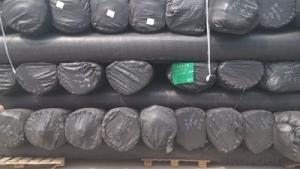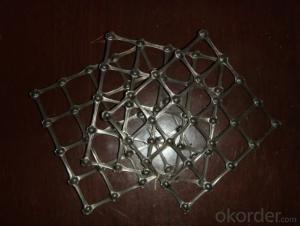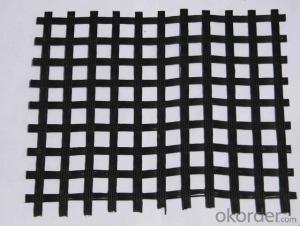HDPE Geomembrane for Environmental Projects water conservancy projects landfill mining canal:
- Loading Port:
- Tianjin
- Payment Terms:
- TT OR LC
- Min Order Qty:
- 88 m²
- Supply Capability:
- 1800000 m²/month
OKorder Service Pledge
OKorder Financial Service
You Might Also Like
Introduction of CNBM
China National Building Materials (Group) Corporation (CNBM) is a state-owned enterprise in charge of administrative affairs in China building materials industry. Established in 1984, CNBM is a large group corporation of building materials with total assets of RMB 25 billion and a total staff of 30,000. Now CNBM owns more than 200 subsidiaries in and abroad the country, including wholly-owned corporations and joint ventures.
FAQ of geosynthetics :
What is geosynthetics ?
Geosynthetics form a perfect erosion control fabric used extremely widely in civil engineering to stabilize and reinforce slopes and soil under or next to roads, railways, dams, water reservoirs etc.. They can be easily applied which minimizes the time of construction, as well as they limit the resources and materials necessary.
What kinds of geosynthetics we have ?
Non-woven geotextile, geogrids, geocells, GCL, Geomembranes, Geonets, Geocomposites etc .
What is the geosynthetics used for ?
Hydraulic
Lagooning and Water Treatment, Ornamental Ponds, Golf Courses
Aquaculture and Desalination,Water Lagoons,Tanks, Reservoirs, Liquid Waste,Floating Cover Solutions, Drainage and Filtration
Environment
Tailing ponds, Leach mining,Landfills,Landfill Capping,Protection against corrosion,Vertical Barriers
Civil Works
Erosion Control,Secondary Containment,Tunnels,Linear and Surface Works,Consolidation of Margins,Soil Reinforcement,Soil Separation.
Building - Parkings,Roofing,Soundproofing
The description of HDPE Geomembrane for Environmental Projects water conservancy projects landfill mining canal
Geomembranes are impermeable geosynthetics that, until recently, were mainly used as canal and pond liners. However, modern technology has broadened liner applications to include landfills, wastewater treatment lagoons, oil and gas exploration (including hydraulic fracturing or "fracking"), aquaculture, irrigation ponds and remediation. In many of these applications, a nonwoven geotextile is used as a cushion to protect the geomembrane. In general, geomembrane liners offer excellent puncture resistance and can withstand a wide range of chemicals and temperatures. They are also highly flexible and conform well to the subgrade.

Specification of HDPE Geomembrane for Environmental Projects water conservancy projects landfill mining canal:
I. Thickness: 0.3mm-3. Omm
2.4m-9m in roll width, the length as client ' s request
Features or Property of HDPE Geomembrane for Environmental Projects water conservancy projects landfill mining canal:
I. Good flexibility
2. For service temperature range: -700C-+1IOoC
3. Corrosion resistance, aging resistance
4. Excellent environmental stress cracking resistance property
5. High tensile strength and elongation
Application of HDPE Geomembrane for Environmental Projects water conservancy projects landfill mining canal:
I. Municipal environmental projects, water conservancy projects
2. Landfill cap(closures), mining heap leach pads
3. Pond liner, canal linings, tank linings, raw water treatment reservoirs, retention ponds
4. Waste water treatment lagoon, secondary containment
Production standard:
I. GB/T17643-2011
2. CJ/T234-2006
3. GRI-GM13
Area |
|
Hydraulic | Lagooning and Water Treatment, Ornamental Ponds, Golf Courses Aquaculture and Desalination Water LagoonsTanks, Reservoirs, Liquid WasteFloating Cover SolutionsDrainage and FiltrationShading Cover Solutions |
Environment | Tailing ponds, Leach mining,Landfills,Landfill Capping,Protection against corrosion,Vertical Barriers |
Civil Works | Erosion Control, Secondary Containment, Tunnels,Linear and Surface Works,Consolidation of Margins,Soil Reinforcement,Soil Separation. |
Building | Parkings,Roofing,Soundproofing building |
- Q:Evaluation criteria and technical disclosure of geogrid.. Know how to share. Thank you
- 2) according to the design of the location, along the road to the laying of the grid, laying the grille, should pay attention to the connection between the grid and straightening smooth. Grille of the longitudinal and transverse joints can use nylon or polyester rope sewn or U nail connection method between the grid as a whole, grid overlapping width not less than 20cm, in the direction of the stress intensity of the joint shall not be less than the design tensile strength of materials. The grid distortion, fold, overlap, is not conducive to play its role, thus laying by hands straightened, the grid is smooth and uniform, geogrid every 1.5-2.0m paved with hook nail fixed on the ground.
- Q:Are geogrids suitable for slope stabilization?
- Yes, geogrids are suitable for slope stabilization. Geogrids are commonly used in civil engineering projects for reinforcing slopes and retaining walls. They provide stability by distributing the load and preventing soil erosion, thus effectively stabilizing slopes and preventing landslides.
- Q:How to connect the geogrid with the panel in the reinforced earth retaining wall?
- When the geogrid is laid in the curve and the corner, the adjacent earthwork grid is currently used in the reinforced earth retaining wall of the assembled panel, and the common wall of the assembled panel module will have gaps or overlaps (see Figure 1). For the outward bending of the geogrid, there are different forms such as rectangle, hexagon, shape, L shape and groove shape. Panel module will appear at the corner of the gap,In order to ensure the continuity of the reinforced soil, laying in the void design based on the engineering environment need to be flexible, prefabricated into various shapes, can provide the same type of geogrid small pieces of good, and cover all the reinforced area; for bend shop visual effect; can also use color cement, add art wall. No panel reinforcement design of geogrid, in the corner there will be some overlap in geogrid, geogrid reinforced earth retaining wall is also called anti package type or wrap-reinforcedearth retaining wall, the wall is made of mesh bags to fill the overlap coefficient of friction will be reduced, must be laying a layer of 10mm ~ 20mm thick the soil geogrid anti package into each layer of geogrid is a special connecting rod is connected with the shape of the coarse sand layer, separate the two layer of Geogrid to ensure friction resistance. As a whole, the mesh bag filling has been mixed for local growth of grass and shrub seeds, seeds, after months of growth after the formation of green ecological wall. The utility model not only protects the safety of the geogrid, but also beautifies the environment of the retaining wall project.
- Q:What are the long-term durability characteristics of geogrids?
- Geogrids have excellent long-term durability characteristics. They are typically made from high-strength materials such as polyester or polypropylene, which are resistant to degradation caused by UV exposure, chemical exposure, and biological factors. Geogrids also have high tensile strength, allowing them to withstand heavy loads and maintain their structural integrity over time. Additionally, they have low creep and deformation rates, meaning they can maintain their original shape and performance for an extended period. Overall, geogrids have proven to be highly durable and reliable for various applications in civil engineering and construction.
- Q:Can geogrids be used in ground improvement for industrial facilities?
- Yes, geogrids can be used in ground improvement for industrial facilities. Geogrids are often employed in various geotechnical applications, including stabilizing and reinforcing soil in areas with weak or unstable ground conditions. In the context of industrial facilities, geogrids can be used to enhance the load-bearing capacity of the ground, prevent soil erosion, and provide additional stability to the foundation. By installing geogrids, the overall performance and durability of the ground can be improved, making them a suitable solution for ground improvement in industrial settings.
- Q:How do geogrids enhance the performance of flexible retaining structures?
- Geogrids enhance the performance of flexible retaining structures by providing reinforcement and stability to the soil. They distribute the loads more evenly, reducing the stress on the structure and increasing its overall strength. Geogrids also prevent soil erosion and improve drainage, ensuring the long-term integrity and durability of the retaining structure.
- Q:Glass fiber grille modified asphalt, polyester grille coated PVC.
- This is the business secret of the production enterprise.
- Q:Can geogrids be used in retaining wall facing systems?
- Yes, geogrids can be used in retaining wall facing systems. Geogrids are commonly used to reinforce and stabilize soil in retaining walls, and they can help enhance the overall strength and stability of the wall. They are typically placed within the soil layers behind the facing system to distribute the forces and prevent excessive movement or failure of the retaining wall.
- Q:What is the effect of junction strength on geogrid performance?
- The junction strength of a geogrid directly impacts its performance. A higher junction strength enhances the overall stability and load-bearing capacity of the geogrid, allowing it to effectively restrain soil movement and distribute loads. It also improves the geogrid's resistance to deformation, puncture, and tearing. In summary, a strong junction enhances the geogrid's effectiveness and durability in various geotechnical applications.
- Q:The difference between geocell and geogrid
- Geocell characteristics1, with flexible, transport may be collapsed, the construction can be a Lacheng mesh, fill soil, gravel, concrete and other loose material, which has the structure of strong lateral limit and rigid body.2, light material, wear resistance, chemical stability, light oxygen aging, acid and alkali resistance, suitable for different soil and desert soil conditions.3, the higher lateral restrictions and non slip, anti deformation, effectively enhance the bearing capacity of the subgrade and scattered load.4, to change the height of geocell, welding distance and other geometric dimensions to meet the needs of different projects.5, flexible and easy to transport small size, convenient connection, construction speed.
1. Manufacturer Overview |
|
|---|---|
| Location | |
| Year Established | |
| Annual Output Value | |
| Main Markets | |
| Company Certifications | |
2. Manufacturer Certificates |
|
|---|---|
| a) Certification Name | |
| Range | |
| Reference | |
| Validity Period | |
3. Manufacturer Capability |
|
|---|---|
| a)Trade Capacity | |
| Nearest Port | |
| Export Percentage | |
| No.of Employees in Trade Department | |
| Language Spoken: | |
| b)Factory Information | |
| Factory Size: | |
| No. of Production Lines | |
| Contract Manufacturing | |
| Product Price Range | |
Send your message to us
HDPE Geomembrane for Environmental Projects water conservancy projects landfill mining canal:
- Loading Port:
- Tianjin
- Payment Terms:
- TT OR LC
- Min Order Qty:
- 88 m²
- Supply Capability:
- 1800000 m²/month
OKorder Service Pledge
OKorder Financial Service
Similar products
New products
Hot products
Related keywords






























